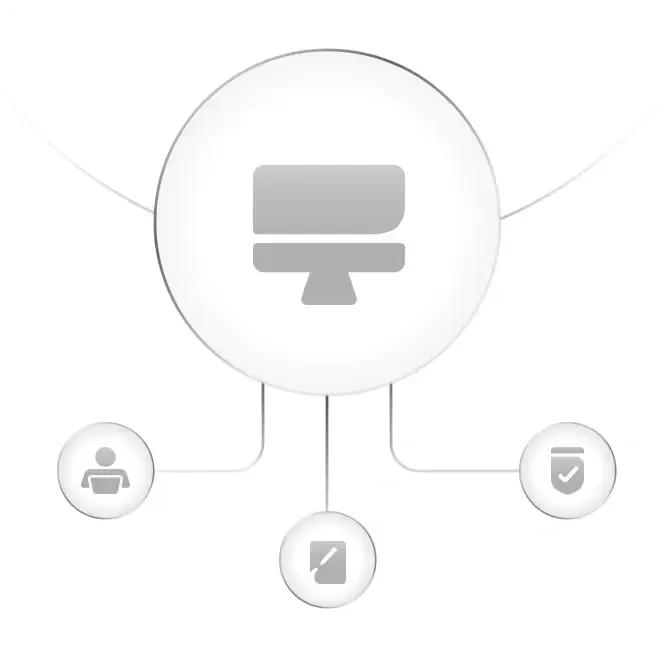Acceptable Use of IT Resources Policy
Think of it as a code of conduct for the digital world: the acceptable use of IT resources policy ensures the responsible and secure use of a company's It assets. It defines digital guidelines for using IT resources, providing clear examples of both acceptable and unacceptable use, and lays out rules for passwords and data confidentiality.

Created by
Ahmed Abdel Wahab
|
Human Resources Adviser
Share the calculator with an HR college
What’s included in the acceptable use of IT resources policy?
Acceptable use of IT resources policy clearly outlines the optimal use of the company's technology. It defines permissible activities—primarily work-related—while also clarifying the extent of personal use allowed.
The policy explicitly lists unacceptable activities, such as illegal actions, inappropriate content, and data breaches. It provides specific guidelines for systems and networks, covering aspects like passwords, remote access, and software installation.
Recognizing that personal devices used for work need the same protection as company-owned ones, the policy details secure usage standards to safeguard business interests. It also stresses the importance of protecting sensitive and confidential information and the rules for its display and sharing.
Finally, the IT policy framework details the consequences of violations, outlining disciplinary actions, which can include employment termination as per the law.
Acceptable Use of IT Resources Policy - Table of contents
1. Business Use Only
2. Prohibited Activities
3. Software and Licensing
4. Security and Passwords
5. Monitoring and Auditing
6. Data Protection and Confidentiality
7. Remote Access and Devices
8. Disciplinary Consequences
Why do you need an acceptable use of IT resources policy?
Protecting the IT infrastructure from misuse.
A legal framework for penalizing misuse and indiscipline.
Reducing cyber risks such as data breaches, malware, and viruses.
Creating a secure, productive, and highly efficient digital work environment.
How do you use the it policy template?
Download the template and review the content.
Customize it with name, logo, and the permissible scope of usage flexibility.
Add it to Jisr HR system for easy access at any time.
Ensure compliance by getting the Acceptable Use of IT Resources policy reviewed by a legal/HR expert.
See Jisr in action
Scale HR operations, manage talent, control spend – all in one platform with Jisr. Get started in weeks, not months.

FAQs
Writing an effective Acceptable Use of IT policy (AUP) ensures responsible and secure technology use. Start by defining the policy's purpose (e.g., asset protection, productivity, legal compliance). Clearly state who it applies to (employees, contractors, visitors) and what resources it covers (devices, networks, software).
Research industry benchmarks and relevant laws. Crucially, detail acceptable and unacceptable uses, including specific guidelines for passwords, remote access, and data handling. Emphasize confidentiality and outline disciplinary consequences for violations, aligning with Saudi labor law. Finally, specify a review and update frequency to keep the policy current.
Information technology (IT) is fundamental to nearly every aspect of modern work. For example, a common use of IT involves a sales team utilizing Customer Relationship Management (CRM) software to track client interactions, while the HR department uses specialized HR software for employee management. Beyond dedicated systems, IT is crucial for everyday tasks like browsing the internet, downloading necessary software, and securely exchanging documents. It also powers essential communication, enabling teams to collaborate seamlessly through email, instant messages, and various online tools.
Acceptable use of IT refers to the authorized and appropriate ways employees utilize a company's computer systems, networks, and other technological resources. It ensures the security, integrity, and efficient operation of these resources while protecting the organization from legal and financial risks.
Key uses include:
- Primarily Work-Related Use: IT resources should mainly support business activities.
- Limited Personal Use: Some personal use may be allowed, provided it doesn't interfere with work or violate policies.
- Security & Protection: Users must safeguard resources, report breaches, and avoid unauthorized devices.
- Respectful & Legal Conduct: Prohibits abusive, offensive, or illegal content.
- Compliance: Adherence to all IT policies, including data protection and intellectual property.
Acceptable Use Policy (AUP) applies to everyone who interacts with the company's IT resources. This broad scope ensures that all users understand their responsibilities. This includes permanent employees, temporary workers, interns, and consultants. Furthermore, visitors and any third parties accessing computers, electronic devices, networks, or work systems must also strictly adhere to the IT infrastructure policies and procedures. Essentially, anyone who uses IT, must follow the policy.
The primary purpose of Information Technology (IT) is to offer effective solutions for managing information. Key objectives include:
- Accelerating Access to Information: IT enables quick retrieval of data from diverse sources, keeping users updated with real-time information.
- Enhancing Efficiency and Productivity: By automating tasks and streamlining processes, IT speeds up operations that would otherwise be manual and time-consuming.
- Supporting Better Decision-Making: IT analyzes vast amounts of data, providing real-time insights that empower informed, data-driven choices for businesses.
- Facilitating Communication and Collaboration: IT tools like email and video conferencing enable seamless global interaction and efficient teamwork.
- Reducing Human Errors: Automating repetitive tasks through IT minimizes manual mistakes, ensuring greater accuracy and consistency.